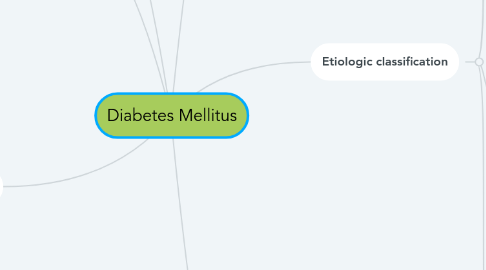
1. Diagnosis
1.1. Symptoms of diabetes plus ramdom blood glucose concentration >11,1 mmol/L
1.2. Fasting plasma glucose
1.3. Hemoglobin A1c >6.5%
1.4. 2h plasma glucose > 11,1 mmol/L during an oral glucose tolerance test
2. Risk Factors for Type 2 DM
2.1. Family history of diabetes
2.1.1. parent or sibiling with type 2 DM
2.2. Obesity
2.2.1. IMC > 25kg/m²
2.2.2. ethnically relevant definition for overweight
2.3. Physical incativity
2.4. Race/ethnicity
2.4.1. african american
2.4.2. latino
2.4.3. native american
2.4.4. asian american
2.4.5. pacific islander
2.5. Previously identified with impaired fasting glucose, impaired glucose tolerance or an hemoglobin A1c of 5.7 - 6.4%
2.6. History of gestational DM or delivery of baby > 4kg
2.7. Hypertension (blood pressure >140/90 mmHg)
2.8. HDL cholesterol level < 35 mg/dL and/or triglyceride level > 250 mg/dL
2.9. Polycystic ovary syndrome
2.10. History of cardiovascular disease
3. Glucose tolerance
3.1. Normal glucose homeostasis
3.2. DM
3.3. Impaired glucose homeostasis
4. Definition
4.1. Commom metabolic disorder that share phenotype of hyperglycemia
5. Etiologic classification
5.1. Type 1
5.1.1. beta cell destruction
5.1.2. Immune mediated
5.1.3. Idiopathic
5.2. Type 2
5.3. Other specific types of diabetes
5.3.1. Genetic defects of beta cell development or function characterized by mutations
5.3.2. Genetic defects ininsulin action
5.3.2.1. Type A insulin resistance
5.3.2.2. Leprechaunism
5.3.2.3. Lipodystrophy syndromes
5.3.3. Diseases of the exocrine pancreas
5.3.3.1. Pancreatitis
5.3.3.2. Pamcreatectomy
5.3.3.3. Neoplasia
5.3.3.4. Cystic fibrosis
5.3.3.5. Hemochromatosis
5.3.4. Endocrinophaties
5.3.4.1. Acromegaly
5.3.4.2. Cushing's syndrome
5.3.4.3. Glucagonoma
5.3.4.4. Hyperthyroidism
5.3.4.5. Aldosteronoma
5.3.4.6. Somatostatinoma
5.3.5. Drug or chemical induced
5.3.6. Infections
5.3.6.1. Congenital rubella
5.3.6.2. Cytomegalovirus
5.3.7. Other genetic syndromes
5.3.7.1. down's syndrome
5.3.7.2. Klinefelter's syndrome
5.3.7.3. Turner's syndrome
5.3.7.4. Huntington's chorea
5.4. Gestacional diabetes mellitus
5.4.1. insulin resistance is related to the metabolic changes of late pregnancy, and the increased insulin requirements may lead to impaired glucose tolerance
6. Pathogenesis
6.1. TYPE 1 DM
6.1.1. Result of the interactions of genetic, environmental and immunologic factors that ultimately lead to the destruction of the pancreatic beta cells and insulin deficiency
6.1.1.1. Autoimune beta cell destruction
6.1.1.1.1. Beta cell mass begin to decrease and insulin secretion progressively declines, although normal glucose tolerance is maintained
6.1.2. Any age
6.1.2.1. Most commonly before 20 years
6.2. TYPE 2 DM
6.2.1. Insulin resistance and abnormal insulin secretion
6.2.2. Likely encompasses a range of disorders with common phenotype of hyperglycemia
6.2.3. Has a strong genetic component
6.2.3.1. Individuals with parent with type 2 DM have an ancreased risk od diabetes
6.2.4. Characterized by:
6.2.4.1. impaired insulin secretion
6.2.4.2. insulin resistance
6.2.4.3. excessive hepatic glucose production
6.2.4.4. abnormal fat metabolism
6.2.4.4.1. obesity - visceral or central - is very common in type 2 DM

